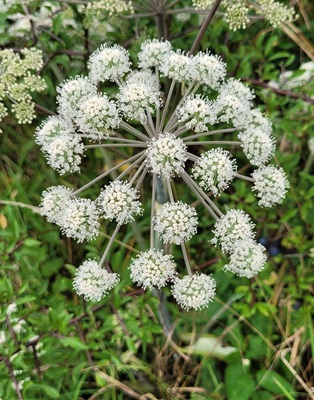Flower Properties
| Property | Value |
|---|---|
| English Name | Angelica - Wild |
| MainColor | White |
| PlantType | |
| Growth Type | |
| Season | August |
| ImageUrl | Angelica-001 |
| Photographer | DP |
| Location | Tatton |
| Human Toxicity |
Flower Details
Description
Wild Angelica is a tall, biennial herb with large, feathery leaves and clusters of small white flowers. It can grow up to 2.5 metres in height and has a distinctive hollow stem. The plant emits a strong, sweet aroma when crushed.
Distribution
This species is native to Europe and parts of Asia, commonly found in damp, woodland areas, riverbanks, and meadows. It thrives in rich, moist soils and can often be seen in the wild.
Medicinal/Other Uses

✅ Historically, Wild Angelica has been used in traditional medicine for digestive issues and as a diuretic. Its roots and leaves have also been used to flavour foods and beverages.
Edibility

The young leaves and stems can be consumed when cooked, while the roots are often used in herbal preparations. However, caution is advised as some parts may be bitter or toxic if not prepared properly.
Human Toxicity

Avoid consuming large quantities as it may cause skin irritation or allergic reactions in some individuals. It is also important to ensure proper identification, as it can be confused with toxic species. Human toxicity: ingestion of large amounts may cause digestive upset or skin reactions due to photosensitivity.
Pet Toxicity

Non Toxic - generally considered safe for pets, but ingestion in large quantities may still cause mild gastrointestinal upset.
Active Compounds
The plant contains essential oils, coumarins, and flavonoids, which contribute to its aroma and potential medicinal properties.
